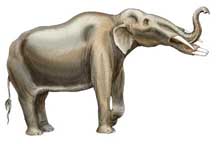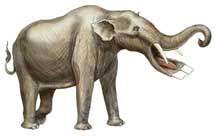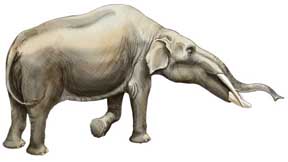SHOVELTUSKERS
Broad, flat, lower tusks which formed an enormous shovel-like structure.
------------------------------------------------------------------------

Florida Shoveltusker
Amebelodon floridanus
· Pronunciation– AM-e-BELL-o-don FLOR-i-DAY-nus
· Synonyms–Amebelodon hicksi, Amebelodon paladentatus
· In Tusks! exhibit?– Yes, an upper molar
· Florida fossil localities– Mixson's Bone Bed (Levy County); Tyner
Farm Site (Alachua County); other sites in Alachua and in Marion Counties
· Geological time– Late Miocene
· Chronological time– ~9 to 8 million years ago
· Moderately large species.
· Long, relatively narrow lower tusks shaped like a great shovel.
· Upper tusks with straight enamel bands.
· The large upper tusks wore against the shovel-like lower tusks.
BACK TO TIMELINE

Britt's Shoveltusker
Amebelodon britti
· Pronunciation– AM-e-BELL-o-don BRIT-eye
· Synonyms– Konobelodon britti
· In Tusks! exhibit?– Yes, a reconstructed mandible, a
femur, and a lower molar
· Florida fossil localities– Moss Acres (Marion County)
· Geological time– Very late Miocene, very early Pliocene
· Chronological time– ~6 to 4.5 million years ago
· One of the largest Florida proboscideans even larger than A. floridanus
· Long, relatively narrow lower tusks shaped like a shovel.
· Upper tusks with straight enamel bands.
· The large upper tusks wore against the shovel-like lower tusks.
BACK
TO TIMELINE

Loomis' Shoveltusker
Torynobelodon loomisi
· Pronunciation– toe-REEN-o-BELL-o-don LOOM-is-eye
· Synonyms– Platybelodon loomisi
· In Tusks! exhibit?– No
· Geological time– Very late Miocene
· Chronological time– ~7 to 6 million years ago
· Short, relatively broad lower tusks shaped like a great shovel.
· Upper tusks reduced, especially in females.
· Platybelodon [Torynobelodon] came over from Asia separately from Amebelodon.
· "T. loomisi has well-developed dorsal and ventral wear facets
very similar to those observed in A. cf. barbourensis, implying that both of
these animals dug plants out of coarse substrates, perhaps terrestrial soils."
(Lambert 1992, p. 138)
BACK TO TIME


